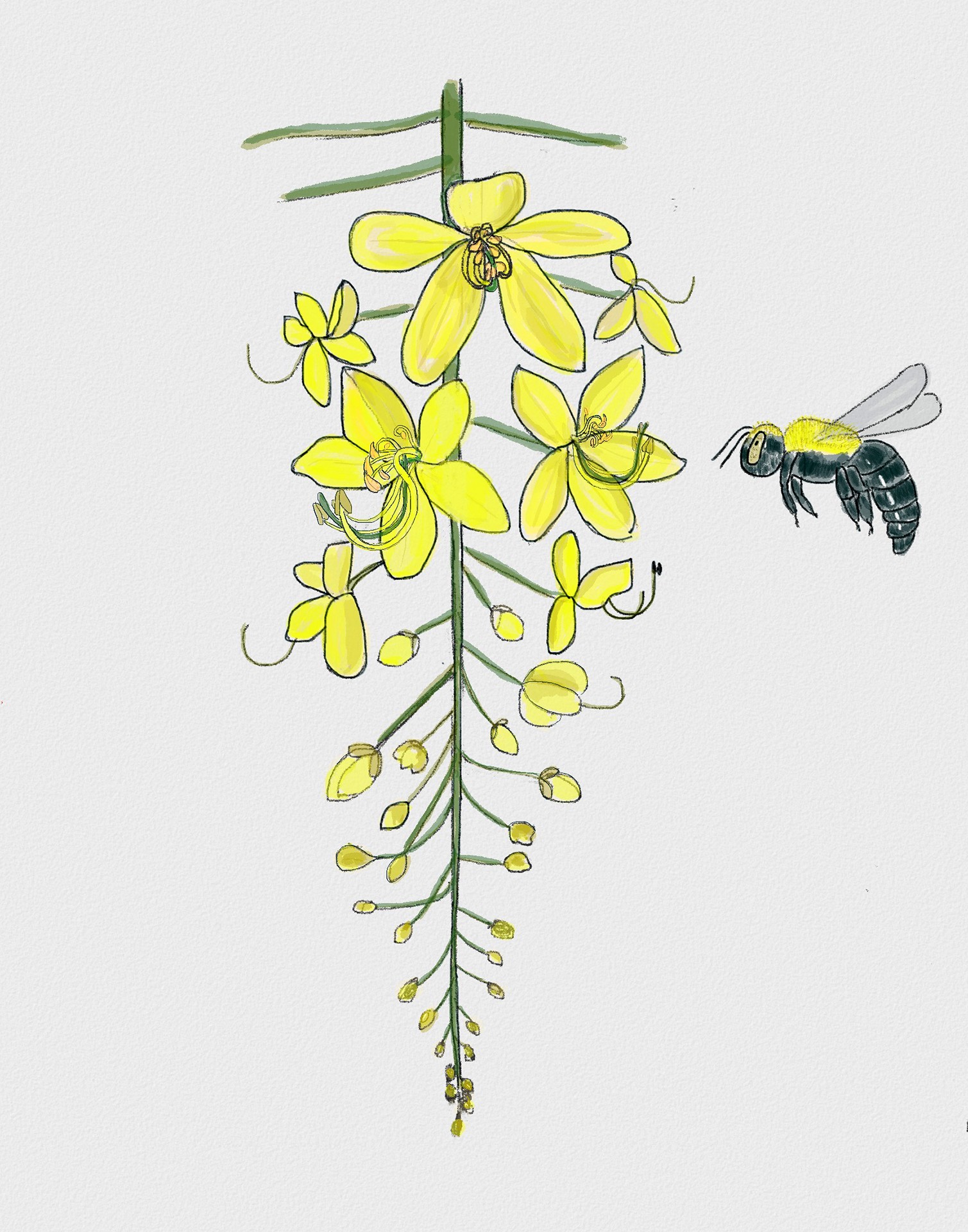Sure, there’s a wealth of flora and fauna to seek out in our sanctuaries, reserves and jungles. Wildlife enthusiasts will always be drawn to, well, wild spaces, but in the quiet time between each adventure, we should remember there’s a wide range of fascinating biodiversity to encounter in our cities, too. Through this new series, we encourage the Nature inFocus community to explore our urban biodiversity, to notice the often-overlooked creatures in our midst, and to appreciate their fascinating ecology and behaviour. Each story will focus on a single species representing different taxa, and will be illustrated by a different artist. This is the fourth story in the series. Look out for the next installment, all about Flying Foxes next month.
Remember walking around your city on a hot, sunny day and being dazzled by shimmering golden chandeliers, magnificently drooping on a smart brown tree? If these golden blossoms have not charmed you yet, it is never too late to take notice of the Golden Shower Tree (Cassia fistula).
Except, for now, you’re going to have to wait till summer rolls around again. This medium-sized deciduous tree blossoms in its full glory mostly between March and May in the Indian subcontinent. The flowers are canary-yellow and arranged in tapering bunches. Each flower has 5 rounded petals with distinctly long filaments, each bearing anthers (stamen). Its tubular pods can hold up to 100 seeds.
The Golden Shower Tree’s scientific name is derived from words Cassia, meaning aromatic bark (like Cinnamon) and fistula, indicating tubular or pipe-like shape, which describes the pods. It is a popular ornamental tree worldwide and has multiple medicinal properties. It is called ‘Aragvadha’ which means ‘disease killer’ in Ayurveda, and is used to treat several dermal, gastrointestinal and cardiac problems.
The tree is native to India and other countries in South and Southeast Asia. A variety of local names in different Indian languages demonstrates its widespread occurrence the country. Common names range from Amaltas in Hindi, Bahava in Marathi and Vishu Konnai in Malayalam. Interestingly, in West Bengal, the Golden Shower Tree’s local name – Bandar Lathi (meaning monkey’s stick) is derived from the supposition that monkeys are particularly fond of the sweet pulp around the seeds and by eating them, help in dispersing them. The Golden Shower Tree is also mentioned in various Sanskrit scriptures and literary works by different names like Karṇikara, Suvarnaka, Kritmala, etc.
As the scorching summer goes by, the tree attracts a wide range of creatures including insects, birds, artists and biologists, to name a few. Its ecological significance is truly something to appreciate – evident from the rich biodiversity it supports and the dynamic biological interactions it sustains. Among insect pollinators (bees and butterflies), C. fistula relies on Carpenter bees (Xylocopa species) for effective pollination and reproduction. This is achieved by a specialised mechanism called ‘buzz pollination’, where vibrations generated by a bee hovering near the flower induce the pollen grains to break out of the anthers and attach to the bee’s body.
Weaver Ants (Oecophylla smaragdina), on the other hand, lurk around the flowers for a different reward. They use the blossoms as hunting platforms to prey on unsuspecting pollinators that visit the flowers. Another interesting association is one that involves male Oriental Fruit Flies (Bactrocera dorsalis) that come to feed on the flowers. Methyl eugenol (a chemical with a clove-like odour) present in the flowers is thought to play a role in synthesising pheromones, used to attract mates in these fruit flies.
Although the flowers are the star attractions, the leaves support a community of their own. Greater Short-nosed Fruit Bats (Cynopterus sphinx) consume the leaves of the Golden Shower Tree, which are rich in protein and calcium. Butterflies like Mottled Emigrant (Catopsilia pyranthe), Common Emigrant (Catopsilia pomona) and Common Grass Yellow (Eurema hecabe), belonging to the family Pieridae, lay eggs on the leaves of C. fistula. The leaves are later chomped upon by the caterpillars that emerge from the eggs.
The Golden Shower Tree has diverse associations within varied cultures and belief systems. In India, the flower blossoms are used as offerings to Lord Vishnu. C. fistula has been protected and worshipped as a sacred tree (called Sthala Vriksha) and conserved in sacred groves in southern India. In Kerala, it is believed that the monsoon arrives 45 days after the first profuse flowering of C. fistula.
The tree holds significance in other countries too. In Laos, the flowers form an integral part of New Year celebrations. In Thailand, the yellow blossoms are considered to represent the royal family.
It is truly one of the joys of summer to watch these unassuming trees burst into showers of warmth when they blossom. So the next time you walk past a Cassia fistula tree, we hope you’ll look up, take a moment to appreciate its aesthetics, and remember its ecological and cultural associations.
Last month, we wrote about the Blue Pansy. Read the story here.

